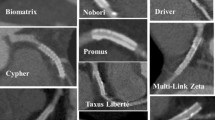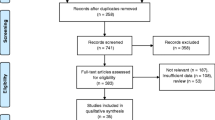Abstract
Evaluation of in-stent restenosis (ISR) by computed tomography coronary angiography (CTCA) is less invasive but often impossible. We aimed to create a scoring model for predicting which drug-eluting stents (DES) cannot be evaluated with CTCA. We enrolled 757 consecutive implanted DES assessed with CTCA. Non-diagnostic evaluation was defined as poor/not evaluative by two different observers. These stents were randomly divided into a derivation (n = 379) and validation (n = 378) group. In the derivation group, we assessed predictors using logistic regression analysis and created a scoring model that would stratify non-diagnostic evaluation of DES-ISR. The validity of this scoring model was evaluated in the validation group using receiver-operating characteristic analysis. The percentage of non-diagnostic stents was 19/21% in the derivation/validation group (p = 0.71). Non-diagnostic evaluation was independently associated with implanted stent diameter (2.25–2.5. vs. 2.5–3 vs. > 3.0 mm), severe calcification, stent-in-stent lesion, and type of DES (stainless vs. CoCr vs. PtCr) in the derivation group. The predicting system of implanted DES non-diagnostic by CTCA (PIDENT) for non-diagnostic evaluation, including these four baseline factors, was derived (C-statistic = 0.86 in derivation group, cutoff: 8 points). The PIDENT score had a high predictive value for non-diagnostic DES in the validation model (C-statistic = 0.87, sensitivity 86%, specificity 74%, cutoff 8 points, p < 0.001). The PIDENT score, consisting of baseline characteristics including implanted stent diameter, severe calcification, stent-in-stent lesion, and type of DES, could identify non-diagnostic evaluation of DES-ISR with CTCA. The PIDENT score was valuable in reducing nonevaluable and meaningless CTCA for DES-ISR.




Similar content being viewed by others
References
Moschovitis A, Cook S, Meier B (2010) Percutaneous coronary interventions in Europe in 2006. EuroIntervention 6:189–194
Holmes DR Jr, Leon MB, Moses JW, Popma JJ, Cutlip D, Fitzgerald PJ, Brown C, Fischell T, Wong SC, Midei M, Snead D, Kuntz RE (2004) Analysis of 1 year clinical outcomes in the SIRIUS trial; a randomized trial of a sirolimus-eluting stent versus a standard stent in patients at high risk for coronary restenosis. Circulation 109:634–640
Morice MC, Colombo A, Meier B, Serruys P, Tamburino C, Guagliumi G, Sousa E, Stoll HP, Trial Investigators REALITY (2006) Sirolimus- vs paclitaxel-eluting stents in de novocoronary artery lesions; the REALITY trial: a randomized controlled trial. JAMA 295:895–904
Iglesias JF, Heg D, Roffi M, Tüller D, Noble S, Muller O, Moarof I, Cook S, Weilenmann D, Kaiser C, Cuculi F, Häner J, Jüni P, Windecker S, Pilgrim T (2019) Long-term effect of ultrathin-strut versus thin-strut drug-eluting stents in patients with small vessel coronary artery disease undergoing percutaneous coronary intervention: a subgroup analysis of the BIOSCIENCE randomized trial. Circ Cardiovasc Interv 12:e008024
Lee CW, Ahn JM, Lee JY, Kim WJ, Park DW, Kang SJ, Lee SW, Kim YH, Park SW, Park SJ (2014) Long-term (8 year) outcomes and predictors of major adverse cardiac events after full metal jacket drug-eluting stent implantation. Catheter Cardiovasc Interv 84:361–365
Lee PH, Lee SW, Yun SC, Bae J, Ahn JM, Park DW, Kang SJ, Kim YH, Lee CW, Park SW, Park SJ (2017) Full metal jacket with drug-eluting stents for coronary chronic total occlusion. JACC Cardiovasc Interv 10:1405–1412
Ribichini F, Romano M, Rosiello R, La Vecchia L, Cabianca E, Caramanno G, Milazzo D, Loschiavo P, Rigattieri S, Musarò S, Pironi B, Fiscella A, Amico F, Indolfi C, Spaccarotella C, Bartorelli A, Trabattoni D, Della Rovere F, Rolandi A, Beqaraj F, Belli R, Sangiorgio P, Villani R, Berni A, Sheiban I, Lopera Quijada MJ, Cappi B, Ribaldi L, Vassanelli C (2013) A clinical and angiographic study of the XIENCE V everolimus-eluting coronary stent system in the treatment of patients with multivessel coronary artery disease: the EXECUTIVE trial (EXecutive RCT: evaluating XIENCE V in a multi vessel disease). JACC Cardiovasc Interv 6:1012–1022
Park KW, Kang J, Kang SH, Ahn HS, Lee HY, Kang HJ, Koo BK, Chae IH, Youn TJ, Oh BH, Park YB, Kandzari DE, Kim HS (2013) Usefulness of the SYNTAX and clinical SYNTAX scores in predicting clinical outcome after unrestricted use of sirolimus- and everolimus-eluting stents. Circ J 77:2912–2921
Flohr TG, McCollough CH, Bruder H, Petersilka M, Gruber K, Süss C, Grasruck M, Stierstorfer K, Krauss B, Raupach R, Primak AN, Küttner A, Achenbach S, Becker C, Kopp A, Ohnesorge BM (2006) First performance evaluation of a dual-source CT (DSCT) system. Eur Radiol 16:256–268
Juan YH, Huang YC, Sun Z, Hsieh IC, Chan WH, Chen CC, Hung KC, Wen MS, Wan YL (2004) The evolution and investigation of native coronary arteries in patients after coronary stent implantation: a study by 320-detector CT angiography. Int J Cardiovasc Imaging 30(Suppl 1):13–24
Gaspar T, Halon DA, Lewis BS, Adawi S, Schliamser JE, Rubinshtein R, Flugelman MY, Peled N (2005) Diagnosis of coronary in-stent restenosis with multidetector row spiral computed tomography. J Am Coll Cardiol 46:1573–1579
Kong LY, Jin ZY, Zhang SY, Zhang ZH, Wang YN, Song L, Zhang XN, Zhang YQ (2009) Assessment of coronary stents by 64-slice computed tomography: in-stent lumen visibility and patency. Chin Med Sci J 24:156–160
Gilard M, Cornily JC, Pennec PY, Le Gal G, Nonent M, Mansourati J, Blanc JJ, Boschat J (2006) Assessment of coronary artery stents by 16 slice computed tomography. Heart 92:58–61
Rixe J, Achenbach S, Ropers D, Baum U, Kuettner A, Ropers U, Bautz W, Daniel WG, Anders K (2006) Assessment of coronary artery stent restenosis by 64-slice multidetector computed tomography. Eur Heart J 27:2567–2572
Mark DB, Berman DS, Budoff MJ, Carr JJ, Gerber TC, Hecht HS, Hlatky MA, Hodgson JM, Lauer MS, Miller JM, Morin RL, Mukherjee D, Poon M, Rubin GD, Schwartz RS (2010) ACCF/ACR/AHA/NASCI/SAIP/SCAI/SCCT 2010 Expert consensus document on coronary computed tomographic angiography: a report of the American college of cardiology foundation task force on expert consensus documents. Circulation 121:2509–2543
Byrne RA, Stone GW, Ormiston J, Kastrati A (2017) Coronary balloon angioplasty, stents, and scaf-folds. Lancet 390:781–792
Stefanini GG, Taniwaki M, Windecker S (2014) Coronary stents: novel developments. Heart 100:1051–1061
Price MJ, Saito S, Shlofmitz RA, Spriggs DJ, Attubato M, McLaurin B, Popma Almonacid A, Brar S, Liu M, Moe E, Mehran R (2017) First report of the resolute onyx 2.0 mm zotarolimus-eluting stent for the treatment of coronary lesions with very small reference vessel diameter. JACC Cardiovasc Interv 10:1381–1388
Tsuda T, Ishii H, Ichimiya S, Kanashiro M, Watanabe J, Takefuji M, Aoyama T, Suzuki S, Tanaka A, Matsubara T, Murohara T (2015) Assessment of in-stent restenosis using high-definition computed tomography with a new gemstone detector. Circ J 79:1542–1548
Andreini D, Pontone G, Bartorelli AL, Mushtaq S, Trabattoni D, Bertella E, Cortinovis S, Annoni A, Formenti A, Ballerini G, Agostoni P, Fiorentini C, Pepi M (2011) High diagnostic accuracy of prospective ECG-gating 64-slice computed tomography coronary angiography for the detection of in-stent restenosis: in-stent restenosis assessment by low-dose MDCT. Eur Radiol 21:1430–1438
Nishida K, Kimura T, Kawai K, Miyano I, Nakaoka Y, Yamamoto S, Kaname N, Seki S, Kubokawa S, Fukatani M, Hamashige N, Morimoto T, Mitsudo K (2013) Comparison of outcomes using the sirolimus-eluting stent in calcified versus non-calcified native coronary lesions in patients on- versus not on-chronic hemodialysis (from the j-Cypher registry). Am J Cardiol 112:647–655
Turgut O, Yilmaz A, Yalta K, Yilmaz BM, Ozyol A, Kendirlioglu O, Karadas F, Tandogan I (2007) Tortuosity of coronary arteries: an indicator for impaired left ventricular relaxation? Int J Cardiovasc Imaging 23:671–677
Chung MS, Yang DH, Kim YH, Roh JH, Song J, Kang JW, Ahn JM, Park DW, Kang SJ, Lee SW, Lee CW, Park SW, Park SJ, Lim TH (2016) Stent fracture and longitudinal compression detected on coronary CT angiography in the first- and new-generation drug-eluting stents. Int J Cardiovasc Imaging 32:637–646
Sullivan LM, Massaro JM, D’Agostino RB Sr (2004) Presentation of multivariate data for clinical use: the Framingham study risk score functions. Stat Med 23:1631–1660
Kirtane AJ, Yeung AC, Ball M, Carr J, O’Shaughnessy C, Mauri L, Liu M, Leon MB (2020) Long-term (5 year) clinical evaluation of the resolute zotarolimus-eluting coronary stent: the RESOLUTE US clinical trial. Catheter Cardiovasc Interv 95:1067–1073
Yano H, Horinaka S, Ishikawa M, Ishimitsu T (2017) Efficacy of everolimus-eluting stent implantation in patients with small coronary arteries (≤ 2.5 mm): outcomes of 3 year clinical follow-up. Heart Vessels 32:796–803
Dai T, Wang J-R, Peng-Fei Hu (2018) Diagnostic performance of computed tomography angiography in the detection of coronary artery in-stent restenosis: evidence from an updated meta-analysis. Eur Radiol 28:1373–1382
Yoshioka K, Tanaka R, Muranaka K, Sasaki T, Ueda T, Chiba T, Takeda K, Sugawara T (2015) Subtraction coronary CT angiography using second generation 320-detector row CT. Int J Cardiovasc Imaging 31(Suppl 1):51–58
Amanuma M, Kondo T, Sano T, Sekine T, Takayanagi T, Matsutani H, Arai T, Morita H, Ishizaka K, Arakita K, Iwasa A, Takase S (2015) Subtraction coronary computed tomography in patients with severe calcification. Int J Cardiovasc Imaging 31:1635–1642
Amanuma M, Kondo T, Sano T, Takayanagi T, Matsutani H, Sekine T, Arai T, Morita H, Ishizaka K, Arakita K, Iwasa A, Takase S (2016) Assessment of coronary in-stent restenosis: value of subtraction coronary computed tomography angiography. Int J Cardiovasc Imaging 32:661–670
Menown IB, Noad R, Garcia EJ, Meredith I (2010) The platinum chromium element stent platform: from alloy, to design, to clinical practice. Adv Ther 27:129–141
O’Brien BJ, Stinson JS, Larsen SR, Eppihimer MJ, Carroll WM (2010) A platinum-chromium steel for cardiovascular stents. Biomaterials 31:3755–3761
Turco MA (2011) The integrity® bare-metal stent made by continuous sinusoid technology. Expert Rev Med Devices 8:303–306
Kobayashi N, Ito Y, Nakano M, Araki M, Hirano K, Yamawaki M, Takimura H, Sakamoto Y, Tsukahara R, Muramatsu T (2015) Incidence and characteristics of late catch-up phenomenon between sirolimus-eluting stent and everolimus-eluting stent: a propensity matched study. J Interv Cardiol 28:551–562
Leschka S, Alkadhi H, Plass A, Desbiolles L, Grünenfelder J, Marincek B, Wildermuth S (2005) Accuracy of MSCT coronary angiography with 64-slice technology: first experience. Eur Heart J 26:1482–1487
Carrabba N, Bamoshmoosh M, Carusi LM, Parodi G, Valenti R, Migliorini A, Fanfani F, Antoniucci D (2007) Usefulness of 64-slice multidetector computed tomography for detecting drug eluting in-stent restenosis. Am J Cardiol 100:1754–1758
Funding
None.
Author information
Authors and Affiliations
Corresponding author
Ethics declarations
Conflict of interest
None.
Additional information
Publisher's Note
Springer Nature remains neutral with regard to jurisdictional claims in published maps and institutional affiliations.
This author takes responsibility for all aspects of the reliability and freedom from bias of the data presented and their discussed interpretation.
Rights and permissions
About this article
Cite this article
Honda, Y., Yamawaki, M., Mori, S. et al. Scoring model to predict low image quality of drug-eluting stent evaluated by computed tomography coronary angiography. Heart Vessels 37, 229–238 (2022). https://doi.org/10.1007/s00380-021-01918-8
Received:
Accepted:
Published:
Issue Date:
DOI: https://doi.org/10.1007/s00380-021-01918-8




